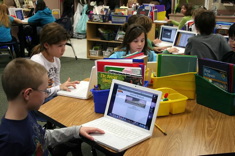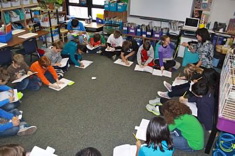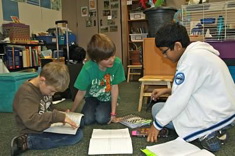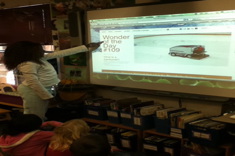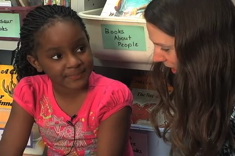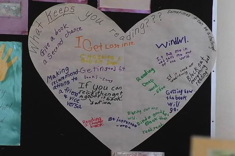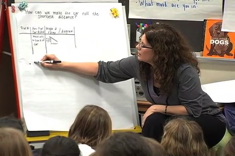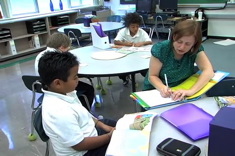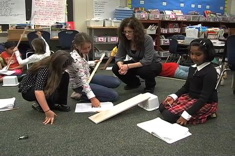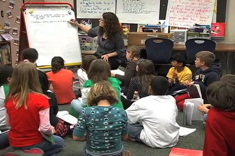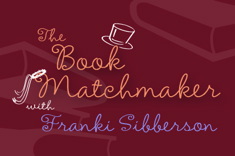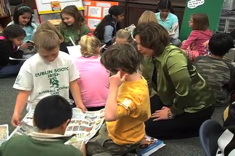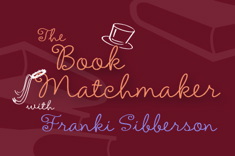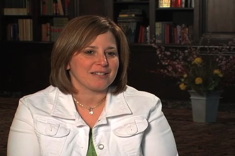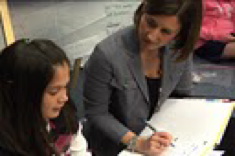3rd
Latest Content
Wild Facts
Wild Facts is a terrific example of how Andrea Smith's intermediate students naturally connect web resources with content learning.
Spelling Rules — Or Does It?
Heather Rader introduces a new spelling series and maps out the topics she’ll be tackling.
Three Rules Worthy of Spelling Inquiry
It seems like every spelling rule has an exception — so which ones must be taught? Heather Rader shares the three spelling rules worth any teacher’s time.
Digital Reading: Another Facet of a Classroom Library
The good news? There are lots of free and low-cost digital books for young readers on the web. The bad news? The quality of many of them is mediocre at best. Andrea Smith highlights three web-based resources for digital books that are affordable and also high quality.
Writers, Choice and Independence (Part II)
In this second installment of a two-part series, Aimee Buckner writes about the value of open choice writing units.
Tuesday Trades: A New Literacy Ritual in My Classroom
Tuesday Trades are a terrific way to increase peer book recommendations. Andrea Smith created this new weekly activity with her intermediate students, building on existing workshop routines.
Born Wonders: Tapping Student Interest in Animals, Babies, and Books
Cute Alert – what’s more adorable than babies or animals? Perhaps baby animals! Andrea Smith shares an addictive web resource that will instantly hook students of any age. It’s zoo postings of newborn animals from around the world, with many literacy connections.
Letting Go After Holding on Tight: Reflecting on the Last Days of School
Andrea Smith writes about how our instincts as parents and teachers merge to make it so hard to say goodbye at the end of the school year.
Math Journals
Julie Johnson rekindles her love affair with math when she incorporates journals and sees her students become more adept at organizing and explaining their thinking.
Strawberries, Fun, and Student Blogging
Andrea Smith evaluates the success of her new student blogging program.
Writers, Choice and Independence (Part I)
What does true independence look like among young readers and writers? A chance comment from a visitor to Aimee Buckner's classroom gets her pondering the amount of choice children have during units of study.
Wonderopolis: Nonfiction, Technology, and Web-Based Independent Learning
Wonderopolis hits the sweet spot so many of us are looking for in web resources for students, delivering free, engaging, high-quality nonfiction text and video in small chunks that can easily be integrated into literacy and science workshops. Andrea Smith explains how she uses Wonderopolis daily with her students.
Pencil Plans
The care and use of the lowly pencil in classrooms says a lot about what we value and our relationships with students.
Read Alouds for the First Day of School
Choice Literacy readers share their favorite read alouds for the start of the year.
Revising Titles Minilesson
In this minilesson from Franki Sibberson’s grades 3 and 4 classroom, Franki takes students through the process of selecting and revising titles. She uses the poem “Confessions of a Reader” by Carol Wilcox as a mentor text.
Injecting Writing into Everything: Prediction Stories
What happens between kindergarten and upper elementary grades to make students more hesitant about making predictions? Heather Rader has books and teaching suggestions for building prediction skills.
Connecting Students, Wall Charts, and Reading
In this conference with third-grade student Jeffrey, Beth Lawson helps this young reader think through the importance of developing stamina to get through the first 50 pages of a book.
Book Matchmaker: New Books for Intermediate Readers
From humor to novels in verse, Franki Sibberson shares her top picks for intermediate readers in this Book Matchmaker.
Science Writing Workshop Part 1
How can teachers connect the principles of writer’s workshop with science explorations? In this first of a three-part video series, Jennifer Morgan leads her 3rd and 4th students through the process of observing, talking, and writing in their science journals as they perform an experiment. In Part I, she presents the task to students and connects it with previous learning.
Book Clubs: Setting the Stage with Conferring
We want students to discuss books in thoughtful, sophisticated ways in book clubs, but those skills don’t always come naturally. (Wait – do those skills ever come naturally?) Beth Lawson explains how she confers with individual children in her third-grade classroom to prepare them for independent book clubs with peers.
Science Writing: Small Groups
In this second video in a three-part series, Jennifer Morgan leads her grades 3 and 4 students as they work together in small groups on a science and writing task.
Science Workshop Whole Class Debrief
In this final video in a three-part series, Jennifer Morgan discusses what was learned during a science observation and writing activity in her grades 3 and 4 classroom.
Book Matchmaker: Teaching Inferring to Intermediate Students
In this installment of Book Matchmaker, Franki Sibberson discusses the challenges of finding a range of books to teach the concept of inferring to grades 3-5 students.
Making Connections as a Reader and a Scientist
Heather Rader finds that reading is at the heart of scientists’ work.
Book Matchmaker: Characters Across the Grades
In this installment of Book Matchmaker, Franki Sibberson provides a range of books for teaching character development in fiction for grades 3-5 students.
Using Comics in Literacy Workshops
Franki Sibberson works with her 3rd and 4th graders to use comics in the literacy workshop.
Book Matchmaker: Teaching Point of View
In this installment of Book Matchmaker, Franki Sibberson provides a range of books for teaching point of view for grades 3-5 students.
Quick Takes: Advice on Book Hogs
In this quick take video, Franki Sibberson gives advice for dealing with "book hogs" — those students who try to grab any new book when it appears in the classroom library.
Parent Contributions Beyond Instructional Support
Parents want to contribute, but not all contributions are welcome or even helpful when it comes to teaching children how to read and write. Trish Prentice has suggestions for making the most of family skills and willingness to help.
Assessment Conferences: Listening to and Learning from Our Students
Research, decide, and teach – Clare Landrigan and Tammy Mulligan use Lucy Calkins’ wise advice in assessment conferences with children.
Browse Content By
Type
Category
- Assessment Tools
- Big Fresh Archives
- Booklists
- Choice Numeracy
- Classroom Design
- Common Core
- Community Building
- Conferring
- Content Literacy
- Digital Literacy
- English Language Learners
- Equity
- Family Relations
- Free Samples
- Guiding Groups
- Leadership
- Literacy Coaches
- Mentor Texts
- Minilessons
- New Teacher Mentors
- Podcasts
- Poetry
- Quote Collections
- Reading Strategies
- Self Care
- Struggling and Striving Learners
- Talking and Listening
- Teacher Study Groups
- Teaching Reading
- Teaching Writing
- Word Study and Vocabulary
Author
- Melissa Quimby
- Nawal Qarooni
- Gwen Blumberg
- Julie Cox
- The Lead Learners
- Hannah Tills
- Josie Stewart
- Ruth Metcalfe
- Mallory Messenger
- Becca Burk
- Jodie Bailey
- Vivian Chen
- Mary Brower
- Tiffany Abbott Fuller
- Stephanie Affinito
- Ruth Ayres
- Leigh Anne Eck
- Heather Fisher
- Shari Frost
- Julie Johnson
- Suzy Kaback
- Gigi McAllister
- Shirl McPhillips
- Melanie Meehan
- Cathy Mere
- Debbie Miller
- Tara Barnett and Kate Mills
- Tammy Mulligan
- Dana Murphy
- Bitsy Parks
- David Pittman
- Brenda Power
- Heather Rader
- Matt Renwick
- Mandy Robek
- Christy Rush-Levine
- Gretchen Schroeder
- Jen Schwanke
- Brian Sepe
- Katherine Sokolowski
- Stella Villalba
- Jennifer Vincent
Grade Level
Choice Literacy Membership
Articles
Get full access to all Choice Literacy article content
Videos
Get full access to all Choice Literacy video content
Courses
Access Choice Literacy course curriculum and training




